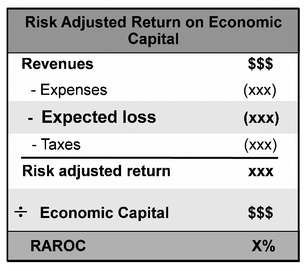Analyzing Risk and Reward
Up to this point, the discussion of risk analysis has focused on measuring, forecasting, projecting, and otherwise trying to pin down a negative risk event. However, as you know, not all risk is negative. No one gets ahead, in business or in life, without taking risks. Therefore, it’s time to look at the positive side of the equation—the rewards that come from taking risks that play out favorably or from building reward into a risky program (such as charging interest rates for consumer credit).
One of the best ways to use risk measures in a day-to-day setting is to get an understanding of how risk and reward are linked. This is done by comparing measures of risk with measures of return.
Key Approaches
There are two primary methods for analyzing risk and reward:
Return Measure or RAROC (Risk-adjusted return on capital). This method, which arrives at a percentage (or measure), begins by noting your net earnings after taxes. Subtract your expected loss (in dollars) from that figure. The difference is the risk-adjusted return. Next, divide that by the economic capital number calculated earlier. This gives you the total risk-adjusted return on capital. There are some minor variants to the RAROC name (such as risk-adjusted return on risk-adjusted capital, RARORAC, or return on economic capital,ROEC, and others, but they represent only minor variants—and sometimes are simply different names for the same thing!). Don’t let them confuse you.

The risk-adjusted return on capital (RAROC) equation enables you to analyze risk and reward accurately.
Contribution measure oreconomic profit,this generates an absolute number, not a percentage. This measure also carries other monikers: NIACC (net income after cost of capital), SVA (shareholder value analysis), and EVA (economic value analysis) are the three most common. It seems that every accounting and consulting firm uses its own creative term for the contribution method, and here again, they are usually the same, or nearly the same, calculation. The basic equation is as follows:
Economic Profit = Risk-Adjusted Return - Cost of Capital × Economic Capital
This method is similar to the return measure. Start by using the same risk-adjusted return number as that calculated in the first step above. Subtract the cost of capital times the economic capital. Cost of capital is usually some sort of hurdle rate or minimum return that the company wants to use as a benchmark for what it receives on its products or it is literally the cost of raising capital. It may be what the company’s investors require as their minimum return for their investment.
This measure is traditionally calculated over the term of a month, quarter, or year, but it can also be calculated over many months, quarters, or years. Make sure everyone in your company is using the same time period.
Putting Them to Use
The return and contribution measures are excellent for analyzing different product lines, business lines, or the relative risk of an entire company. You can even compare one business against another. These measures are often set as something risk and financial managers call “hurdle rates.” That means a minimum RAROC is targeted for a specific measure, such as what you expect each business or product line to return.
Some companies use these measures in their remuneration schemes. They give a bonus to managers who can provide a better risk-adjusted return or economic profit than targeted and to those who make sure their business areas reach that goal level.
(See Chapter 19 for more on rewarding employees.) These measures also serve as the core framework from which to create pricing models that take risk costs into consideration.
The Least You Need to Know
◆ How your business handles a risk event comes down to how well you can measure expected and unexpected loss.
◆ You can use expected and unexpected loss to measure individual risks as well as groups of risk.
◆ A stress test is a great way to measure a company’s financial condition, as well as its risk models.
◆ Convert all of your risk measures to dollars and cents, so you can relate risk to your bottom line.
◆ Businesses become successful by taking risks, so consider risk versus return one of your key measures.
..................Content has been hidden....................
You can't read the all page of ebook, please click here login for view all page.
